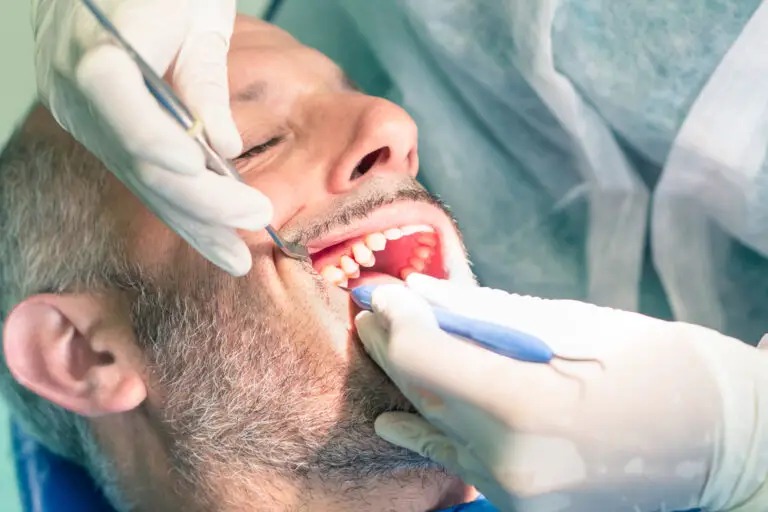It is common for people to notice that their lower teeth are more visible than their upper teeth when speaking or smiling. The degree to which your upper and lower teeth are exposed can vary depending on several factors related to your facial structure, teeth alignment, and speech patterns.
Understanding what causes your lower teeth to be so prominent can help you determine if treatment is warranted for cosmetic or functional purposes. Excessive lower tooth display relative to the upper teeth when talking or smiling may have cosmetic, dental health, or speech implications in some cases.
Typical Tooth Exposure
The amount of upper versus lower teeth that you normally display at rest versus when speaking or smiling can vary. But in general, here are some guidelines for typical tooth exposure:
At Rest
When your mouth is relaxed, with lips gently together:
- Upper teeth: 1 to 2mm of visible tooth below upper lip line
- Lower teeth: 1 to 2mm of visible tooth above lower lip line
Some minor visibility of the upper and lower front teeth edges when the mouth is at rest is common. Overall, both the upper and lower teeth should have similarly minimal exposure. Significant differences in resting top versus bottom tooth display may indicate an alignment issue.
When Speaking
When speaking or smiling without exaggerated effort:
- Upper teeth: Approximately 2 to 4mm visible below upper lip
- Lower teeth: Approximately 2 to 4mm visible above lower lip
Many experts consider 4 to 6mm of upper and lower tooth display to be within an acceptable range when speaking. Beyond 6mm of visible upper or lower tooth may be considered excessive.
Ideally, the amount of exposure of your upper versus lower teeth should be symmetrical when you talk or smile. If your lower teeth consistently display significantly more than your top teeth with speech, it could be considered aesthetically unbalanced.
Factors That Impact Tooth Visibility
Several elements related to your facial structure, dental alignment, and speech patterns influence how much tooth is revealed when your mouth is at rest versus active speech:
1. Lip Position and Shape
Your upper and lower lip structure play a big role in determining how much of your upper versus lower teeth show in different positions.
Resting Lip Position
Some people naturally have a lower lip position that rests lower on the face, revealing more of the lower teeth edges at rest.
Others may have a shorter upper lip, tighter upper lip that keeps more of the upper teeth covered, or fuller lower lip that obscures more of the lower teeth with the mouth relaxed.
Lip Mobility
How much your upper lip can raise and lower when speaking, smiling, or expressing also impacts tooth visibility. If you have naturally stiffer or more limited mobility of your upper lip, this can cause more lower tooth display as the lip will have more difficulty lowering to cover the lower teeth with animation.
People with good upper lip mobility can easily raise their upper lip enough to show the upper teeth, and then relax it back down to obscure more of the lower teeth as needed.
Lip Shape
The shape of your upper and lower lips affects how much tooth they cover as well:
- Thinner lips provide less coverage over the teeth at rest.
- Bow-shaped lips cover more of the upper and lower teeth when relaxed.
- Deepupper lip philtrum columns can “tent” the upper lip in a way that reveals more lower teeth.
2. Jaw Alignment

The way your upper jaw (maxilla) and lower jaw (mandible) fit together also influences how much of the upper versus lower teeth will be displayed.
Underbite/Prognathic Lower Jaw
An underbite refers to a lower jaw that extends outward further than the upper jaw when the mouth is closed.
This prognathic lower jaw alignment causes the lower row of teeth to be positioned substantially in front of the upper teeth. This increased protrusion automatically exposes more of the lower teeth in all positions.
Overbite
The vertical overlap of the upper teeth over the lower teeth is referred to as an overbite. Those with a deepoverbite often have upper teeth that hang over the lower teeth enough to partly obscure them. This can lead to increased visibility of the upper teeth rather than lower.
A shallow overbite with less overlapping of the upper front teeth means that both arches of teeth will tend to show more equally when speaking or smiling.
Open Bite
An open bite refers to lack of vertical overlap of the upper and lower teeth when the mouth is closed. With open bites, there are gaps between the arches.
Having an anterior open bite with space between the upper and lower front teeth will also predispose the lower teeth to be more exposed in all positions.
3. Tooth Positioning
Beyond jaw alignment, the specific positioning of the upper and lower teeth also impacts visibility:
Crowding
Having crowded, crooked lower teeth can push some of the lower teeth outward, leading to greater lower tooth display. Meanwhile, more crooked upper teeth may actually become hidden under the upper lip.
Straightening crooked lower teeth can help reduce excess lower tooth show in some cases.
Gaps Between Lower Teeth
Spacing or gaps between lower teeth will reveal dark holes and more of the lower gingiva (“gumline”) between the teeth. This also increases the apparent amount of lower tooth exposure.
Closing gaps between lower teeth can help reduce the display of gumline tissue and actual tooth surface area revealed with a smile or speech.
Tooth Shape
Protruding or longer/longer-looking lower teeth will also be more visible. For example:
- Longer lower central incisors will show more tooth surface area.
- Bucked “tongue-thrust” lower incisors protrude outward more.
- Gummy smiles with excessive lower gum tissue show make teeth appear longer.
Conversely, shorter or uneven upper teeth may show less tooth structure.
4. Speech Patterns
Beyond your structural facial and dental characteristics, your speech habits also impact relative upper versus lower tooth visibility:
Upper Lip Raising
Some people have speech patterns that involve unconsciously raising their upper lip more extremely when making certain sounds. This reveals much more of the lower teeth.
For example, words with “S” or “F” sounds often cause more upper lip motion and lower tooth display. This can vary greatly by individual.
Emphasized Lip Rolling
Drawing the lips back horizontally to emphasize lip rounding on certain sounds can reveal additional lower tooth surface.
Smile Speech
Those who speak with a very “toothy” smile, drawing the mouth broadly upwards to reveal the upper teeth, will also naturally show more lower tooth structure with their exaggerated smile.
Whereas someone who speaks with a closed-mouth smile shows less of both arches of teeth.
Problems With Excessive Lower Tooth Display

In some cases, lower teeth being significantly more visible than the upper teeth when speaking or smiling can pose issues:
Aesthetic Imbalance
When the lower teeth seem to dominate the appearance of the mouth, it can disrupt facial symmetry and be considered less attractive. The upper incisors and smile frame the face, so inadequate upper tooth display appears unbalanced.
Self-Consciousness
Some people feel very self-conscious and embarrassed if they feel a disproportionate amount of lower gumline and teeth show when they talk. They may limit their smile as a result.
Speech Impairment
Excess lower tooth display during speech can affect pronunciation and cause a “wet” or lispy sound. It may also force affected individuals to compensate by holding tension in the jaw, lips, or tongue, leading to strain.
Accelerated Tooth Damage
Increased exposure of the lower teeth during speech causes more wear and abrasion damage to the tooth enamel over time. This can lead to excessive thinning, chipping, or notching of the lower incisor edges.
Oral Health Issues
Seeing excessive lower gum tissue exposure when speaking could indicate existing gum recession or active periodontal disease issues that require dental treatment.
What Causes Excessive Lower Tooth Display?
If your lower teeth show considerably more than your upper teeth when speaking, what are some possible causes? Here are explanations of the most common factors that can lead to excessive lower tooth display relative to the uppers:
Short or High Upper Lip
A shorter upper lip, or upwardly positioned upper lip, that doesn’t sufficiently cover the upper incisor teeth at rest is perhaps the top reason for increased lower tooth show with facial animation.
Normally, the upper lip should provide just 1-2mm of tooth exposure at rest. But in this case, the high lip position causes the upper teeth to already be exposed even when relaxed. So when the upper lip animates with speech, the lower teeth inevitably show much more.
Vertical Maxillary Excess
In some people, the upper jaw containing the top teeth sits excessively far downward and receded in the face profile. This is referred to as having a vertically excessive maxilla.
With this imbalance, the upper front teeth and smile line are abnormally lowered. So more lower tooth structure is revealed because the lower jaw/teeth are positioned more forward than the recessed upper jaw.
Overclosure/Prognathic Mandible
On the flip side, the lower jaw (mandible) may be overdeveloped in a protruding position, also known as being prognathic. Typically, the upper jaw should protrude slightly farther than the lower jaw.
But in this case, the excessive growth of the lower jaw pushes the lower teeth outward beyond the upper teeth. This overclosure automatically exposes additional lower tooth surfaces.
Open Bites
As mentioned earlier, open bite issues can also expose more lower tooth. Anterior open bites that create space between the upper and lower front teeth are a common cause.
Posterior open bites with space between the back upper and lower teeth will also lead to more lower tooth visibility as the lower jaw drops downward excessively to close the bite. Treating open bites can reduce lower exposure.
Crowding or Gaps
Lower teeth that are severely crowded or crooked may get pushed outward into increased prominence. This reveals more lower tooth surface. Straightening overlapped lower teeth can help reduce lower tooth show.
Meanwhile, gaps or spacing between lower teeth also reveals more dark spaces and increased visibility of the lower gumline. Closing gaps hides more of the lower teeth.
Hypermobile Upper Lip

While stiff upper lip movement reveals more lower teeth, the opposite problem – having an upper lip that raises too easily and excessively, can cause the same issue.
Some people overactively raise their upper lip upward when speaking or smiling, revealing much more lower tooth than normal. Retraining this muscular habit can help.
Protrusive Speech
Individual speech patterns can affect lower tooth display as well. Speaking with the lips pushed substantially forward puts the lower lip in a protruded posture that readily reveals the lower teeth with any animation.
Tongue thrusting, lisp-type speech, and certain regional accents (i.e. stereotypical “New Jersey” speech) can exhibit this tendency.
Lower Lip Licking Habit
Some people have habits like frequently licking their lower lip and holding it in a somewhat protruded position. This essentially stretches the lower lip downward, revealing much more lower tooth structure in the process.
Solutions for Excess Lower Tooth Display
If you are bothered by excessive lower tooth show aesthetically or functionally, what treatment options may help reduce it? Consider discussing these approaches with your dentist:
Botox Lip Injections
Using strategically placed Botox injections along the upper lip can relax the muscles that pull the lip upwards. This reduces active lifting of the upper lip during speech, keeping more of the lower teeth covered.
Botox effects typically last 3-6 months before further injections are required if desired.
Hyaluronic Acid Fillers
Injectable fillers like Juvederm or Restylane can be injected along the vermillion border of the upper lip to add volume. This has the effect of lowering the upper lip position on the face to cover more upper tooth structure.
Most fillers provide 6-12 months of augmented lip fullness before they are naturally metabolized.
Surgical Jaw Realignment
Orthognathic jaw realignment surgery can be performed in some cases to directly impact the protrusive position of either the upper or lower jaw. Moving a protruded lower jaw upwards and back can reduce lower tooth show.
Jaw surgery is a much more intensive process involving orthodontics before and after the procedure and a lengthy recovery. But it offers permanent skeletal change.
Esthetic Dentistry Options
Your dentist has several tools to modify the shape, size, and position of the upper and lower teeth to achieve a more proportional smile:
- Tooth contouring and reshaping
- Dental bonding
- Porcelain veneers
- Crown lengthening or reduction
- Tooth-colored fillings
- Gum contouring or grafts
These approaches alter tooth structure, gumlines, and tooth length appearance to minimize the excessive prominence of the lower teeth.
Orthodontic Treatment
Braces, Invisalign, or other orthodontic methods can reposition the alignment of both arches through bite adjustments and use of rubber bands/elastics. This can close excessive overbites or open bites that expose the lower teeth.
Retraction and uprighting of protruding lower teeth also helps reduce their prominence. Slow orthodontic movement can provide steady improvement over months to years of treatment.
Myofunctional Therapy
In some cases, exercises to strengthen the upper lip muscles and retrain more advantageous speech articulation patterns can help reduce overactive upper lip elevation that exposes too much lower tooth.
This conservative therapy takes consistent effort but helps reprogram the muscles and motions that contribute to excessive lower tooth display. Hands-on therapy may provide added benefit.
Frequently Asked Questions About Bottom Teeth Showing More Than Top Teeth:
Why do my bottom teeth show more than my top teeth when I talk?
The most common reasons your lower teeth show more than your upper teeth when speaking are:
- Naturally shorter or higher positioned upper lip
- Lower jaw protrusion or chin prominence
- Tendency to raise upper lip excessively when speaking
- Dental issues like open bites or crowded lower teeth
What health problems cause bottom teeth to show more?
Excess lower tooth display can be a sign of:
- Gum disease/recession – more visible gum tissue
- Bruxism – overclosed bite wears lower teeth more
- Lower lip sucking habit – stretches lip downward
It can also accelerate dental problems like tooth abrasion or decay.
Is it normal for bottom teeth to show more as you age?
As people age, thinning of tissues in the lower face including the lips allows more lower teeth to show. Jaw recession and missing lower teeth also decrease support for the lower lip.
Mild increase in lower tooth display with aging is common. But pronounced changes may warrant evaluation.
Do veneers make bottom teeth show less?
Yes, porcelain veneers can reshape and lengthen the upper front teeth to cover more of the lower teeth. Veneers on the lower teeth can minimize their prominence as well.
Can Invisalign fix overbite and help bottom teeth show less?
Yes, Invisalign or orthodontic treatment using braces can help impact overbite issues that lead to excessive lower tooth display. Bite adjustment and control of vertical overlap is a primary focus of orthodontic correction.
At what age do bottom teeth not show as much?
As children mature through their pre-teen and early teenage years, lower jaw growth slows relative to the mid-face. This causes the amount of lower tooth display to gradually reduce and even out.
By ages 12-14, the degree of upper and lower tooth show with smiling and talking typically becomes more proportional.






